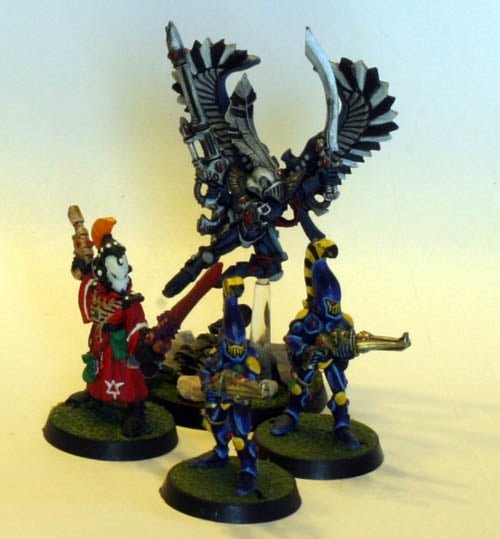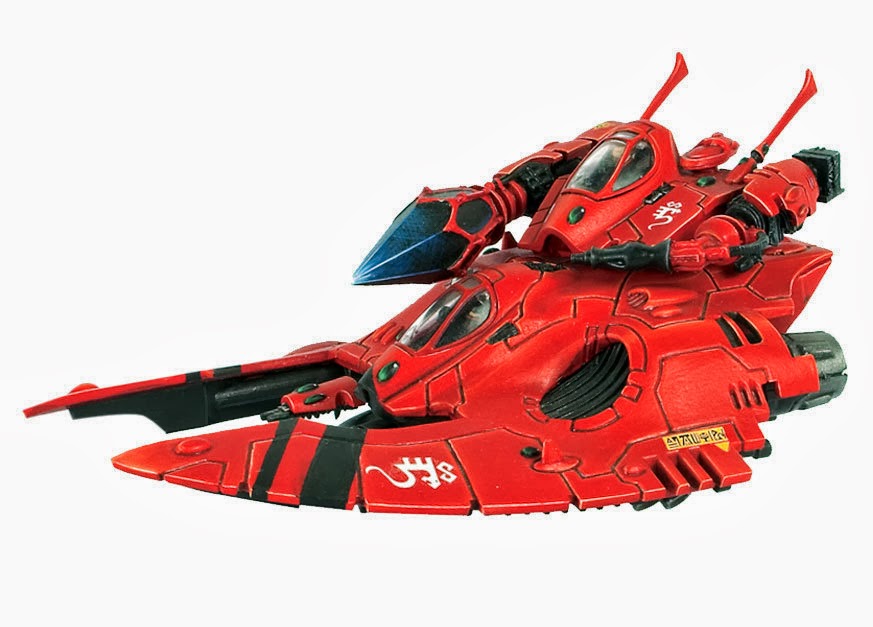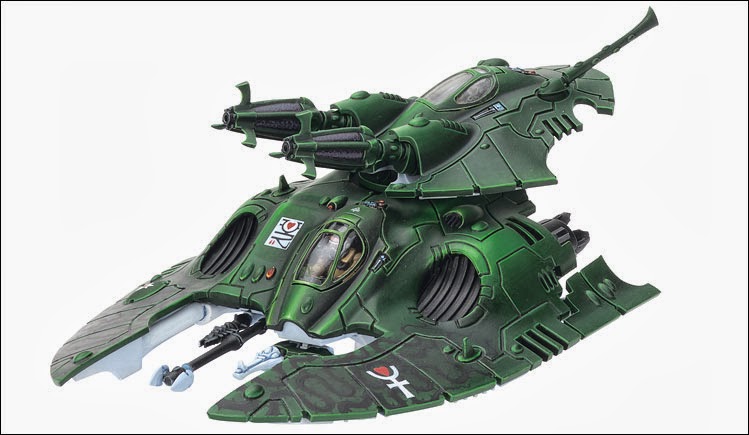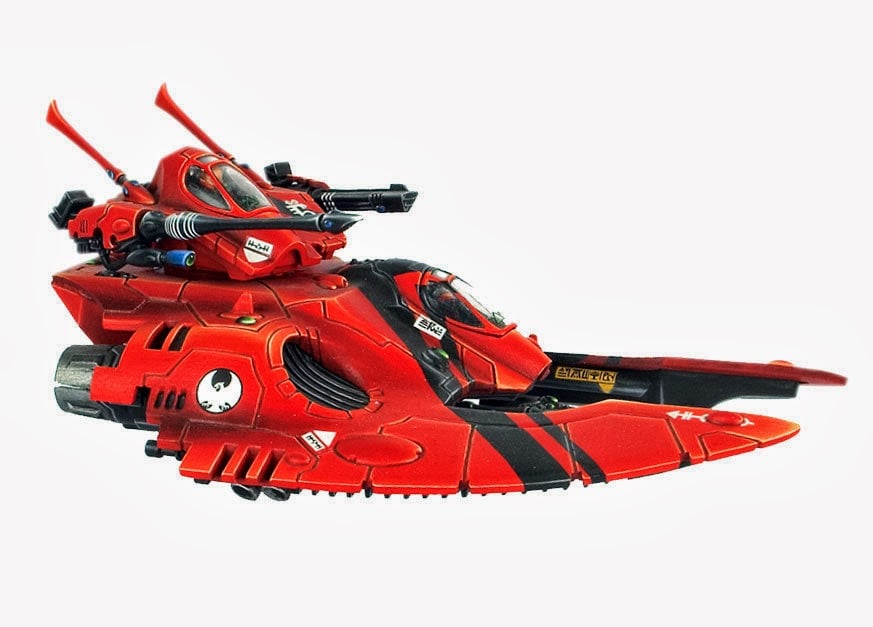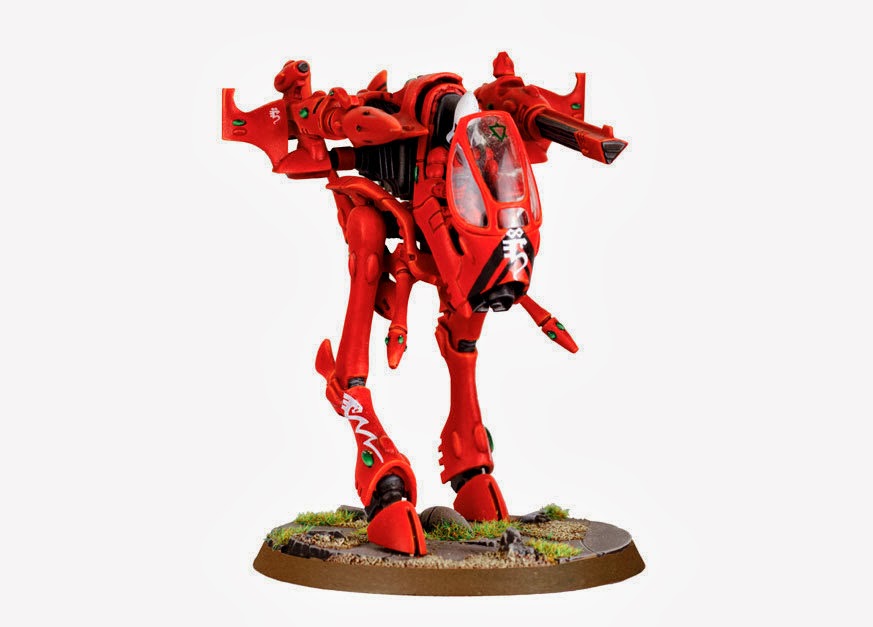40K TACTICS: Eldar Heavy Support – Vehicles

Hey guys, I am Learn2Eel I’m here to continue our series on Codex: Eldar. The Craftworlders are back with a vengeance.
Eldar – Heavy Support – Vehicles
Do you ever feel like halting the charade of arguing and just doing the deed then and there? Do you feel like an engagement simply needs a big gun in order to sway favourably? Do you want to know what the combination of evisceration, laceration, immolation and disintegration results in? Do you ever want to kill someone so hard that they die to death? Well hey, get yourself a new Tau army and let us know how it goes! Jokes aside, the Eldar bring some serious firepower in the Heavy Support section, with each unit typically specialising in destroying a particular kind of enemy. Dark Reapers excel at hunting power-armoured foes such as Space Marines, and jump – or just sit there, speechless and grim – with glee every time they such forces as their quarry. Support Batteries and Falcons are more based upon what you need, as they provide a mix or can be upgraded to suit different roles. The Wraithknight and Wraithlord have similar adaptability, but as tough monsters that can also smash through near anything in a melee. War Walkers are mobile and deadly, usually against vehicles as the codex does lack such quantitative long or medium range anti-tank elsewhere. The Fire Prism is the most versatile of any choice, with multiple fire modes geared to engaging any foe with high success. It helps that all of these units are amongst the most durable in the codex for their type, and with Battle Focus and typical long ranges thrown in, you can afford to sit back or slowly advance at a steady pace. Keeping these precious units alive is as much an investment as the units themselves.
A note here that I will be covering all of the non-vehicular units in a separate article so as to both maximise the detail in each article and reduce the time between each article being posted up.
Fire Prism – Few Eldar weapons are as deadly as that which is mounted upon the Falcon chassis, to which the Fire Prism owes both its fame and name. A deadly skimmer tank that is rightly feared by any enemy with their brains alight, the Fire Prism is a standout in a cast of excellence owing to its sheer firepower and versatility at a great cost. Unlike others of its kind, the Fire Prism is strictly a gun platform; it lacks transport capacity of any kind, ultimately proving to be the only reason to pick a Falcon over the crystalline terror. For sheer mobility, the Fire Prism is as you would expect from any Eldar vehicle; it is a fast skimmer, allowing it to move at cruising speed and still fire both of its weapons at full Ballistic Skill. Given the deadly nature of the vehicle and the defensive benefits received from moving owing to the Jink rule, this is an important advantage that allows the Fire Prism to fire effectively on the move while keeping its distance from potential threats. Given its ‘fast’ classification, it is also capable of a twenty four inch flat out movement to get itself out of a tight spot or into a strong firing position early in the game. To really maximise the effectiveness of this, a useful but expensive upgrade is the Crystal Targeting Matrix; paired with a Fire Prism on the first turn, it can be used to surprise an enemy by moving up, benefiting from a 4+ or 3+ cover save while firing for maximum effect. Like the Wave Serpent, the Fire Prism is also naturally durable, with three hull points and armour values of twelve on the front and sides, with an expected ten on the rear. Though it lacks the almost omniscient – how often does it fail a save, in all honesty? – Serpent Shield, it is still a tough vehicle that, paired with the Jink rule, can be quite difficult to take down short of massed high strength and ignores cover weaponry. Needless to say, however, you should never expect it to survive a punishing volley of lascannon or melta fire; any penetrating hit or high volume strength seven or greater shots can and will destroy the Fire Prism, so be sure to minimise any potential backlash.
As you would expect if you’ve seen the model, the Fire Prism has one heck of a large gun, and it truly doesn’t disappoint. The aptly named Prism Cannon has three firing modes to really diversify the targets it can engage; this undoubtedly gives the Fire Prism its sheer value over other Heavy Support choices. A trait that each share is a whopping sixty inch range that allows it to fire across much of the map that, when paired with its innate speed, give it the range and flexibility to really challenge any vulnerable cog in the enemy battle line. The first fire mode is a strength five AP three large blast, bringing untold devastation to power-armoured infantry of all kinds; it will decimate much of a Space Marine squad reliably, with the only defence for most infantry being a cover save. The second fire mode is a strength seven AP two small blast, geared solely for taking on heavy infantry such as Terminators or for inflicting instant death on Toughness three multiple-wound models like Scarab Swarms or Ripper Swarms. The third and final fire mode is a strength nine AP one lance that, because it reduces enemy armour to twelve if it isn’t already lower, has a rough fifty percent chance of both penetrating and destroying a Land Raider or Monolith in a single deadly strike. Obviously, this allows the Fire Prism to engage nearly any target rather effectively, with perhaps the only exception being the rather rare monstrous creatures. For an army that typically lacks generalist units, the Fire Prism is a stand out because it can annihilate targets indiscriminately with high efficiency; its Ballistic Skill of four makes most of its shots rather reliable, with the inclusion of a ubiquitous Farseer so easily fixing any accuracy issues. Though it doesn’t really need upgrades and is quite cheap to boot, some minimal investments do improve its general effectiveness; upgrading the Shuriken Catapult to a Shuriken Cannon ensures it can bring greater harm to more forces, while Holo Fields give it a sizable boost to durability. A moving 4+ cover save with serious firepower is sure to annoy most opponents rather gravely, and for such reasons alone the Fire Prism is a great vehicle to add to your Eldar force; it fits into nearly any list with its low cost, durability, mobility and sheer firepower.
Night Spinner – As one of three fast skimmers employing the Falcon chassis, the Night Spinner is an admittedly rarer choice because it is designed more for killing light infantry at long and short ranges. The similarities between it and the Fire Prism are rather clear, so I won’t waste time repeating myself save to give a quick summary. As a fast skimmer with an armour of twelve on the front and side – ten on the rear – it is quite durable, benefiting from a 5+ cover save and capable of firing both its weapons at full Ballistic Skill even when moving at cruising speed. It can move flat out up to twenty four inches if need be which, given its somewhat shorter range in comparison to the Fire Prism for the main weapon, is important to familiarize. Like the Fire Prism, two upgrades in particular are highly effective in an all-comers army list; a shuriken cannon for added damage potential, and the holo fields for a nasty defensive boost to a 4+ or 3+ cover save on the move for a well armoured skimmer tank. What really distinguishes the Night Spinner from the competition is the Doomweaver, its main cannon; what is readily apparent is that it has a strength value of seven and an AP of six, allowing it to wound easily but rarely ignoring armour. Similar to the Fire Prism though, there are two distinct firing modes to employ that, despite sharing the same strength and AP, function at entirely separate ranges. However, each has multiple special rules in common that make the weapon more alluring than it would initially appear. Namely, both cause Pinning tests – the former owing to being a Barrage – with Monofilament thrown in; the latter works very well with the sheer number of wounds likely to be caused in each salvo, increasing the chances for armour-ignoring sixes to wound. The boost in strength to eight against anything lacking an Initiative value or with a majority value of three or lower is also handy for instant-death purposes or for destroying vehicles, though it must be said that the Night Spinner isn’t really designed to do anything more than medium damage on vehicles due to the lack of AP modifiers.
The first fire mode is a large blast with the Barrage rule, meaning it always strikes side armour; with a probable Strength eight thrown in, this is quite decent and makes the Night Spinner rather versatile. It is also incredible for sniping out pesky special or heavy weapons in squads, or simply any squad member you need removed; centre the blast over them, and watch as a stream of wounds – a few of them resolved at AP one – are allocated to the hapless warrior. It will also remove hordes of Orks and Tyranids alike from the table with ease, with Ork Nobz in particular feeling the heat if they happen to be exposed. The option to fire blind is also great for minimising the risks to the Night Spinner itself; its long range of forty eight inches is particularly useful here, allowing you to hide in cover and continue your bombardment. The alternate firing mode is instead a torrent template weapon that can be helpfully positioning up to twelve inches away and even turned around to really scare off infantry units with mediocre armour saves. Though the lack of decent AP is somewhat of a concern, the sheer number of wounds you should inflict will likely make up the difference. Nonetheless, it must be said that if you are in range to use the torrent template, fast assault units would be in your threat range and thus you always need to consider whether moving away is in your best interests. All up, the Night Spinner is an effective and somewhat multi-purpose vehicle that only really suffers when put up against the superb Fire Prism; without that competition, it would be a good choice as part of a strong line-up. It has anti-infantry firepower in abundance that can be handily adapted against vehicles semi-reliably, with light infantry in particular feeling the heat.
Falcon – The main battle tank and template to which the Fire Prism and Night Spinner are based, the Falcon is a fast skimmer tank that brings tactical flexibility through speed, transport capabilities and some strong firepower. Unlike the other parts of the ‘trio’, the Falcon is designed less for long range engagements and more for ferrying small, nasty units into the thick of battle while providing strong anti-tank shots all at a similar price to the Wave Serpent. Like the others, it is difficult to shift in comparison to standard Imperial vehicles; the armour values of twelve on the front and side, ten on the rear, give it a lot of breathing room against most anti-tank firepower, with small arms fire bouncing off of its armoured hull. The Jink save provided as a fast skimmer is highly beneficial to its survival chances, with the always worthwhile addition of holo fields boosting that save to a 4+ or 3+. The latter is accessed by moving flat out up to twenty four inches, allowing the Falcon to cover incredible distances; as it also serves the role of a transport for smaller units such as Fire Dragons, this will likely come into play quite often. However, there are some drawbacks to this weighted versatility; for one, it cannot carry Bulky models like a Wave Serpent can, excluding the use of Wraithguard or Wraithblades. Though it may seem a blessing to have three weapons as opposed to two, if you move at cruising speed the Falcon can only fire two weapons at full Ballistic Skill, meaning that the third weapon will be wasted if it isn’t twin-linked. However, it does give you some added flexibility with an additional weapon for engaging different targets, or in case a Weapon Destroyed result occurs. For what doubles as a transport, this isn’t a bad thing at all. With the capability to carry six Eldar models, the Falcon is an ideal transport for smaller units such as Fire Dragons or even Harlequins. As it is not a dedicated transport, it can be employed for a number of units that normally either do not require or cannot access the Wave Serpent. For a general purpose battle tank however, I think it bears mentioning that the Wave Serpent is proving to be the stronger choice owing mainly to the Serpent Shield and lack of an organisation slot.
The firepower on offer from the Falcon is actually quite decent despite the carrying capacity that is unavailable to both the Fire Prism and Night Spinner, though it must be said that, again, moving at cruising speed does limit the use of one of its weapons. It comes stock with both a shuriken cannon and a shuriken catapult for some nice Bladestorm goodness, though the Pulse Laser is decidedly for tank or monster hunting. Firing two shots at a strength of eight with an AP of two, this forty-eight inch range gun is quite deadly to Terminators and Daemon Princes alike. While the Pulse Laser is the signature weapon of the Falcon, its use against general infantry isn’t great and as such you need to ask yourself whether you want your Falcon to be able to engage multiple targets semi-reliably or deal with specific forces, such as tanks, with greater effectiveness. Handily, the shuriken catapult can be upgraded to a shuriken cannon, while the stock cannon can itself be exchanged – for a small price – to a bright lance, scatter laser, starcannon or eldar missile launcher. Each of them adds to either the general purpose fire, anti-infantry or anti-vehicle focus of the vehicle; for anti infantry, take the starcannon, while anti-tank purposes will likely be best served either with the scatter laser or bright lance. Unfortunately, as with elsewhere in the codex, the eldar missile launcher seems strangely over-costed compared to the other heavy weapon options; though still decent, it isn’t as effective as a bright lance in its stated role. In terms of other upgrades, you can make full use of the Falcon’s speed and deliver a nasty alpha strike while simultaneously delivering your embarked forces to the enemy front-line with the Crystal Targeting Matrix. Though expensive for a one-use-only item, it does give you an edge on the first turn and allow you to ignore a potentially tough decision. Rather than choosing to fire and potentially chance First Blood or move up further and lose the chance, you can use both and the benefit of that for even one turn can be quite significant. The Holo Fields are almost mandatory on nearly any Eldar vehicle provided you have the points spare, and for a transport sans battle tank, you will be constantly moving to make full use of them anyway. Others, such as Spirit Stones, are certainly helpful for ensuring the Falcon can at least continue its stated mission of moving and firing. Overall though, the Falcon is a worthy addition to your force, even if it is outdone as both a battle tank and transport by the Wave Serpent.
War Walker Squadron – Though not strictly analogous to Rifleman Dreadnoughts, War Walkers nonetheless serve a very similar purpose with a few tweaks here and there; they offer great firepower at long ranges for a low cost, with decent stats overall. Dissimilar from their Space Marine counterparts is the durability of War Walkers; each has an armour value of ten all around, and only two hull points to spare. Anything from massed bolter fire to a few token shots from plasma weaponry will destroy them far easier than you would hope, particularly given that War Walkers are open-topped and thus any damage roll made against them receives a +1 modifier; not that it really matters with only two hull points, of course. To say that you need to use them smartly would be an under-statement, but with Battle Focus and Fleet thrown in, this is actually quite easy provided your game board has some decent terrain. The simplest use of this, made reliable by Fleet, is to move out of cover, fire, and then run back into cover – preferably that which blocks line of sight – and do so with confidence due to the re-roll for run moves. This is certainly a nasty tactic, although more complicated uses of the rule are possible; remember that not every game board will have terrain to suit that basic strategy, and some poor movement rolls can neuter it pretty quickly. When engaged in a melee War Walkers are, perhaps unsurprisingly, rather pathetic and not worth the ground that they tread. Each has two attacks at Strength five and Initiative five with a Weapon Skill of four, but not only does it ignore their ranged prowess – their stated goal – but krak-grenade-toting units of any kind will rip them apart with ease. With Ancient Doom, they do benefit from Hatred against Slaanesh Daemons and marked Slaanesh Chaos Marines, but as each of the handmaidens of Slaanesh have the Rending special rule, I would do my best to stay the heck away from any of the pesky warp entities. It is nice that the War Walkers are immune to Fear, at least. The Scout redeployment for War Walkers should help you to get into a good position, however; the free movement at the start of the game can be used either to jump into cover or try to move out of sight of enemy units.
Getting the bad stuff out of the way is rather easy when it comes to War Walkers though, as they are truly a great unit with a lot of advantages. For one, they each have a Ballistic Skill of four and easy access to friendly psykers that can grant them re-rolls to hit. Each comes stock with a power field which provides a tasty 5+ invulnerable save, making them quite a bit more durable if they are stuck out in the open or from irritating cover-ignoring weaponry. They are equipped with a pair of shuriken cannons for all purpose fire, but have access to a combination of two from a range of bright lances, scatter lasers, starcannons and eldar missile launchers. Each of them is a cheap upgrade, and choosing which should really come down to what you need in your army; for pure anti-tank, dual bright lance would likely be preferable. For general purposes, dual scatter laser is typically the strongest build due to the high Strength and sheer number of shots. Conversely, the common anti-infantry build is a pair of starcannons for shredding elite and medium soldiers alike. Though expensive, one can even take two missile launchers with flakk missiles for some decent anti-air capabilities outside of a Crimson Hunter or Aegis Defence Line; it is prohibitively costly however, and thus I cannot recommend it personally. Any load-out you choose should prove to be very effective in its stated role, and taken in a squadron of three, War Walkers provide cheap albeit fragile heavy firepower of a greater quantity than anywhere else in the codex. Using their strong mobility and Battle Focus as smartly as with Dire Avengers or other Eldar forces, War Walkers will be a fantastic unit that regularly proves their worth with reliable and efficient firepower.
Next time – Eldar Flyers
I hope you found my thoughts on the Eldar helpful. You can read way more about Codex Eldar, and we are open to any and all responses! So how do you run those brutal and deadly Heavy Support slots fellow Craftworlders?

